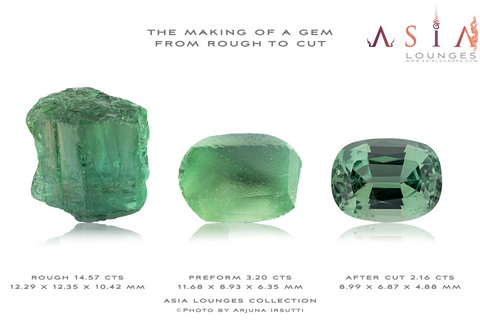Dear Loungers,
Today's post is one I have been wanting to go through for some time: The making of a Gem. How do Mother Earth's finest treasures turn into lovely gems? While not being a cutter myself, I have recently indulged in purchasing rough and proceeded to have it faceted into the gems that make our heart sing!
While I wish I could be exploring with you the cutting process of every single gems we are purchasing at Asia Lounges, I decided to guide you through one of them: this lovely Green Tea Tourmaline!

First came the Rough and with it an idea.
First came the Rough!
The above picture shows the original state of a gem. This is what our favored stones look like as they are being unearthed.
What are we looking for in a rough gem stone? First, whether the gem has a pleasant color and isn't hiding two or more undertone that could potentially hinder its final beauty.
Once we have decided that the color will be pleasant enough, as a buyer, I will be looking, with our cutter, whether the gem is clean, free of inclusions and inner damages, or not. Should the stone prove clean or clean enough for our intended purpose we proceed to place an offer on the stone and eventually, or at least in this case, buy it.

The idea translates as a preformed piece of Rough or Semi-Polished gemstone
We then decide on a shape:
Once the rough has been acquired we need to decide on a shape. Pre - shaping a gem involves cutting the bulk of the rough gemstone, loosing an average of 70 to 80% of the original weight, in order to give the stone its final form.
This process is of capital importance as it will, to an extent, decide whether the purchase was worthy or not. The bigger the weight loss the more expensive the stone becomes, on a per carat basis, making it that much more difficult to sell.
What remains of the Original 14.57 cts of rough Tourmaline is but a shadow of itself: only 2.16 cts of beautiful polished gem remains at the end!
The Final "Cut" Down:
Upon finishing the pre-shaping of the gems, we send the stone to our cutter in order to have the facets cut and polished. These are the final and most delicate phases of them all.
During the cutting phase, the cutter will give the facets proper angles and will, essentially decide whether the stone is too shallow (Read here for more information on the topic) or bottom heavy.
A below par type of cut will have a negative impact on the general appearance of the final gem and thus will decrease its price. Effectively, in the colored gem world it comes as no surprise that the color of the gem is of paramount importance. A shallow stone will tend to "loose" color while a "bottomy" one will tend to be too dark.
It is only after these steps that one can really get to know whether the investment was worth it, as it is then that all inclusions, imperfection and colors will reveal themselves to our eyes. We may have a rough idea of what will the result be upon cutting a gem but never can we be entirely sure.

As you can see with this gem where only 15% of the original weight remains, purchasing and cutting gems can prove to be a tricky and, more often than not, costly yet thrilling business.
We hope you enjoyed this simplified walk through of the gem cutting process and invite you to follow our next posts on the subject with our pals over at Primacut!
If you liked what you have read so far in our pages and want to support A Gem Dealer's Journal, here is a link to our Patreon's Page.
See you soon in the Lounges,


